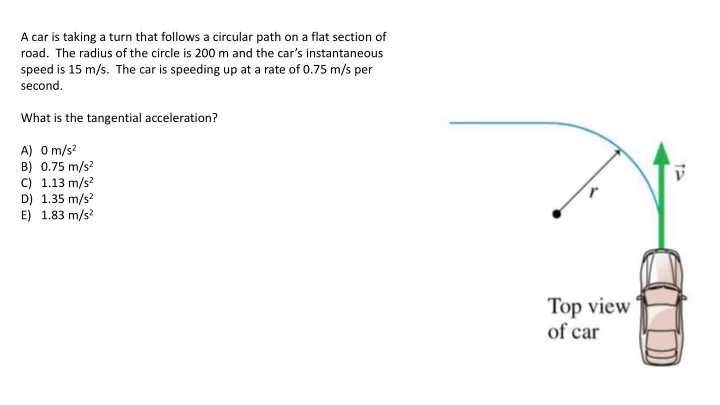

A car is taking a turn that follows a circular path on a flat section of road. The radius of the circle is 200 m and the car’s instantaneous speed is 15 m/s. The car is speeding up at a rate of 0.75 m/s per second. What is the tangential acceleration? A) 0 m/s 2 B) 0.75 m/s 2 C) 1.13 m/s 2 D) 1.35 m/s 2 E) 1.83 m/s 2
A car is taking a turn that follows a circular path on a flat section of road. The radius of the circle is 200 m and the car’s instantaneous speed is 15 m/s. The car is speeding up at a rate of 0.75 m/s per second. What is the radial acceleration? A) 0 m/s 2 B) 0.75 m/s 2 C) 1.13 m/s 2 D) 1.35 m/s 2 E) 1.83 m/s 2
A car is taking a turn that follows a circular path on a flat section of road. The radius of the circle is 200 m and the car’s instantaneous speed is 15 m/s. The car is speeding up at a rate of 0.75 m/s per second. What is the magnitude of the net acceleration? A) 0 m/s 2 B) 0.75 m/s 2 C) 1.13 m/s 2 D) 1.35 m/s 2 E) 1.83 m/s 2
A car is taking a turn that follows a circular path on a flat section of road. The radius of the circle is 200 m and the car’s instantaneous speed is 15 m/s. The car is speeding up at a rate of 0.75 m/s per second. What angle does the net acceleration make with respect to the direction of the instantaneous velocity? A) 0 degrees B) 15 degrees C) 28 degrees D) 56 degrees E) 90 degrees
Knight Problem 8.29 An 85,000 kg stunt plane performs a loop-the-loop, flying in a 260-m-diameter vertical circle. At the point where the plane is flying straight down, its speed is 55 m/s and it is speeding up at a rate of 12 m/s per second. (a) What is the magnitude of the net force on the plane? (b) What angle does the net force make with the horizontal?
Recommend
More recommend